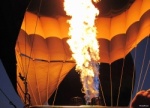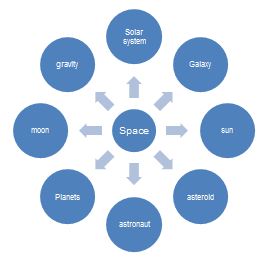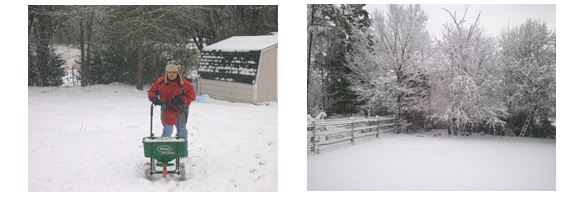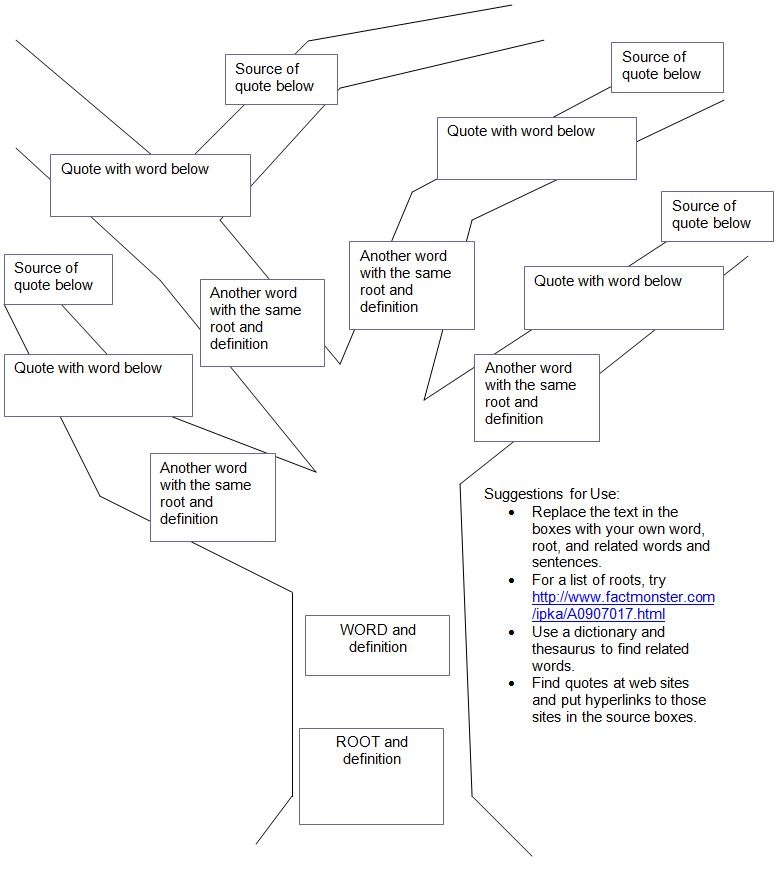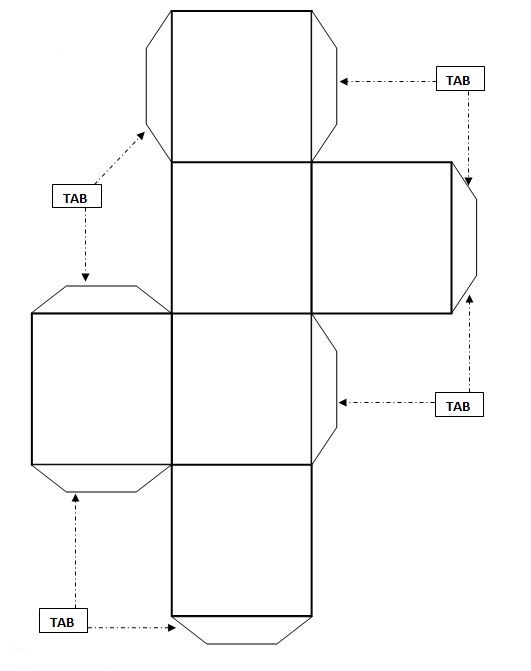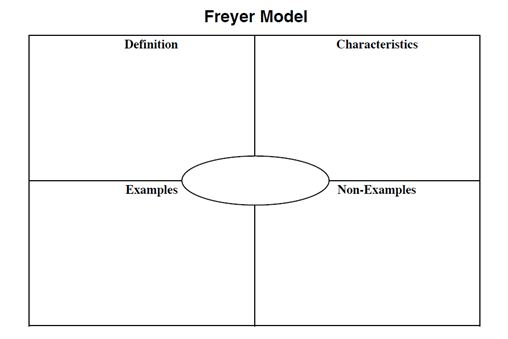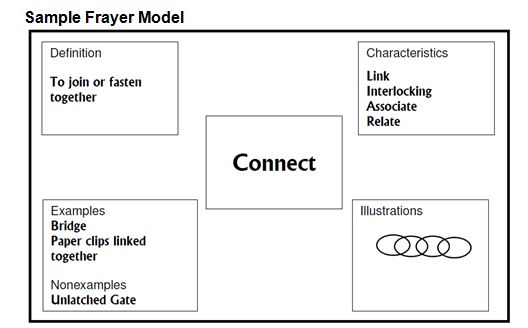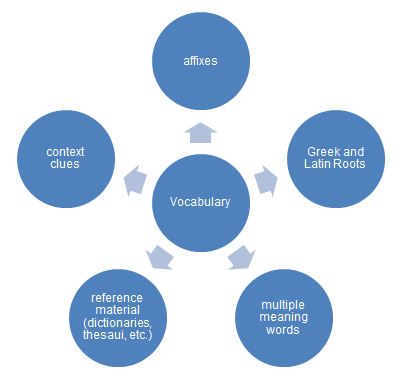Vocabulary and Acquisition Content Module
BACK TO Content Modules
Plot the Course
The rationale
Vocabulary plays a critical role in people's lives and future possibilities. Whether reading for pleasure, reading to understand content (such as science, social studies, etc.), or reading as a daily skill (signs, applications, forms, etc.), determining the meaning of unknown words are life-long skills needed for success. The need to understand the meaning of words is essential for any reader in order to comprehend the text being read. In fact, vocabulary instruction leads to gains in comprehension. Furthermore, vocabulary is the single best indicator of overall knowledge.
The traditional approach of looking up words in the dictionary is not effective and no longer recommended (Stahl, 1999). When students write sentences and answer questions using the dictionary definition, most of the sentences are odd (Miller & Gildea, 1985) and unacceptable (McKeown, 1991; McKeown 1993). Students frequently interpret one or two words from a definition as the entire meaning (Scott & Nagy, 1985) and therefore do not develop full understanding of the word which may interfere with their comprehension. Lastly, it is important to note that lack of vocabulary can be a crucial factor in school failure of disadvantaged students.
Module Goal
The goal of this module is to provide detailed information on vocabulary acquisition and the use of context clues to determine meaning of unknown words and multiple meaning words to teachers of students with disabilities at the elementary and middle school level. This module aims to provide teachers with a general overview of these concepts as well as instructional suggestions so that a teacher can begin to plan instruction for these concepts. Additionally, this module will provide instructors with potential adaptations and modifications to consider when designing materials and instruction for students with severe disabilities.
Module Objectives
After viewing the content module, teachers will:
- Understand the importance of vocabulary development and acquisition.
- Learn instructional strategies for teaching students how to learn unknown and multiple meaning words in context.
- Learn instructional strategies for teaching students how to learn unknown and multiple meaning words through meaningful word parts.
This module focuses on vocabulary instruction within the BDA framework – before, during and after reading. Suggestions for selecting words to study and ways to pre-teach significant terms in the before stage of the lesson will be shared in the "Time for Take Off" section of the module. During and after reading strategies for vocabulary acquisition such as highlighting and studying terms in context will be shared in the "Floating on Air" component. In "Prepare for Landing", strategies to review, reinforce, and apply word learning to real world connections are provided.
Time for Take Off
What is Vocabulary?
Vocabulary is knowledge of words and word meaning in both oral and print language and in productive (speaking and writing) and receptive (listening and reading) forms. Knowing a word by sight and by sound and knowing its dictionary definition are not the same as knowing how to use the word correctly and understanding it when it is heard or seen in various contexts.
Selecting Vocabulary Words
How do we know what words are important to teach? When choosing which vocabulary to teach, it is most important that the teacher selects the most important or most frequently used vocabulary for each lesson. Beck, McKeown, and Kucan (2008) suggest that words can be divided into a system of three tiers. Tier one words are basic words that rarely require instruction including words like clock, baby, and happy. These words are important especially for ELLs. Tier two words are high frequency words that students will encounter often and are found across many domains including words such as fortunate and adapt. Tier three words are low frequency and tend to be domain specific. For example, content area words like isosceles, peninsula, and bucolic are tier three words. Provide instruction for tier three words when the need arises. When selecting words for instruction, teachers will want to focus on tier two words that represent familiar concepts, are more precise or complex words, have high importance or utility, and enhance conceptual understanding. Select approximately 2-5 tier two words depending on the level of the learner(s) to teach from books being read aloud, read independently, or those related to content area reading (i.e., science, social studies, etc.) Check for understanding. Click on the PowerPoint to review how to choose words for vocabulary instruction. \[Insert PowerPoint\]
Vocabulary Journal/Vocabulary Bookmarks
Another approach to selecting words for further exploration is to give students opportunities to collect words they do not understand. The vocabulary log allows students to record any interesting, new, or unknown words they come across in their reading. It asks them to write down the word, the date they found it, where they found it, and what they think it means. Students can record their words onto bookmarks such as the sample found below as an alternative approach. Each week or two, the teacher will bring students together to share the words they've collected, record on a large chart paper, and discuss. Collectively, choose 2-3 words to study in depth over the next few weeks. Students will be more motivated to explore the words more in depth when they have ownership and interest in the selected words.
|
Vocabulary Bookmark
Name:__________________________________ Book:___________________________________
|
| Page ____
Word
|
| Page ____
Word
|
| Page ____
Word
|
| Page ____
Word |
Personal Vocabulary Journal
| My new word is | ||
| It is related to | ||
| I found it | ||
| I think it means | ||
| Definition | ||
| Example | ||
| Picture |
|
Vocabulary Self-Awareness Chart
It is important for students to have opportunities to assess themselves on class vocabulary words. The Vocabulary Self-Assessment Chart gives students multiple opportunities to monitor their learning of vocabulary and helps teachers select vocabulary for additional instruction and study. Vocabulary Self-Awareness Chart Template
| Word | + | 
|
- | Example | Definition |
Procedure:
- Examine the list of words you have written in the first column.
- Put a "+" next to each word you know well, and give an accurate example and definition of the word. Your definition and example must relate to what we are studying.
- Put a "
 " next to any words for which you can write only a definition or example, but not both.
" next to any words for which you can write only a definition or example, but not both.
- Put a "-" next to words that are new to you.
Pre-Reading Vocabulary to Activate and Build Students' Background Knowledge
Once words have been selected for further vocabulary instruction and study, it is important to engage students with the words before, during and after reading. Below you will find a list of pre-reading vocabulary suggestions to preview, activate and build students' background knowledge. While providing vocabulary instruction, you may consider including pictures or objects to make the instruction more concrete for students with disabilities (See Other ideas to support pre-reading vocabulary learning below).
Word Maps
Use word maps to activate prior knowledge about a topic. Begin by selecting a word or topic and recording it in the center of the word map. Before reading, ask students to brainstorm related words, then record their answers on the word map. Review the words and determine if the words could be reorganized and grouped into categories. The teacher and class can brainstorm these categories together, then work together to organize the groups into categories. Return to the word map during and after reading to allow students to add new words based on the reading.
Sample Word Map
Other ideas to support pre-reading vocabulary learning
Use visual representations (images, videos, graphics, etc.) of vocabulary to demonstrate the meaning of words. For example, the following images may be shared to pre-teach the word 'frigid'.
Place vocabulary words on a continuum to demonstrate degree of meaning. For example:
Choosing Vocabulary Words for Instruction powerpoint
Floating on Air
Below is a list of skills from the Language strand of the English Language Arts Common Core State Standards. You will also find the Standard for Vocabulary Acquisition and Use broken down by grade level in the chart below. Before you begin teaching students these skills, it's important to deepen your understanding of effective instructional strategies and approaches to help students be successful with this important learning standard. You will find several instructional strategies provided for each of the skills listed below. Some of these strategies may be familiar to you. For strategies that you need more information about, please view the examples as well as the provided additional resources and instructional templates where appropriate.
Skills from CCSS.ELA-Literacy.L.4
- Determine unknown and multiple meaning words based on grade-level reading and content using a range of strategies.
- Use context as a clue to word meaning.
- Use frequent root words, affixes as a clue to word meanings.
- Use common Greek and Latin roots to determine word meanings.
- Use digital and print references (i.e., dictionaries, thesauri, and glossaries) to determine word meanings.
ELA Common Core State Standards: Vocabulary Acquisition and Use - Grades K-8
| K | L.K.4. Determine or clarify the meaning of unknown and multiple-meaning words and phrases based on kindergarten reading and content.
a. Identify new meanings for familiar words and apply them accurately (e.g., knowing duck is a bird and learning the verb to duck). b. Use the most frequently occurring inflections and affixes (e.g., -ed, -s, re-, un-, pre-, -ful, -less) as a clue to the meaning of an unknown word. |
| 1 | L.1.4. Determine or clarify the meaning of unknown and multiple-meaning words and phrases based on grade 1 reading and content, choosing flexibly from an array of strategies.
a. Use sentence-level context as a clue to the meaning of a word or phrase. b. Use frequently occurring affixes as a clue to the meaning of a word. c. Identify frequently occurring root words (e.g., look) and their inflectional forms (e.g., looks, looked, looking). |
| 2 | L.2.4. Determine or clarify the meaning of unknown and multiple-meaning words and phrases based on grade 2 reading and content, choosing flexibly from an array of strategies.
a. Use sentence-level context as a clue to the meaning of a word or phrase. b. Determine the meaning of the new word formed when a known prefix is added to a known word (e.g., happy/unhappy, tell/retell). c. Use a known root word as a clue to the meaning of an unknown word with the same root (e.g., addition, additional). d. Use knowledge of the meaning of individual words to predict the meaning of compound words (e.g., birdhouse, lighthouse, housefly; bookshelf, notebook, bookmark). e. Use glossaries and beginning dictionaries, both print and digital, to determine or clarify the meaning of words and phrases. |
| 3 | L.3.4. Determine or clarify the meaning of unknown and multiple-meaning word and phrases based on grade 3 reading and content, choosing flexibly from a range of strategies.
a. Use sentence-level context as a clue to the meaning of a word or phrase. b. Determine the meaning of the new word formed when a known affix is added to a known word (e.g., agreeable/disagreeable, comfortable/uncomfortable, care/careless, heat/preheat). c. Use a known root word as a clue to the meaning of an unknown word with the same root (e.g., company, companion). d. Use glossaries or beginning dictionaries, both print and digital, to determine or clarify the precise meaning of key words and phrases. |
| 4 | L.4.4. Determine or clarify the meaning of unknown and multiple-meaning words and phrases based on grade 4 reading and content, choosing flexibly from a range of strategies.
a. Use context (e.g., definitions, examples, or restatements in text) as a clue to the meaning of a word or phrase. b. Use common, grade-appropriate Greek and Latin affixes and roots as clues to the meaning of a word (e.g., telegraph, photograph, autograph). c. Consult reference materials (e.g., dictionaries, glossaries, thesauruses), both print and digital, to find the pronunciation and determine or clarify the precise meaning of key words and phrases. |
| 5 | L.5.4. Determine or clarify the meaning of unknown and multiple-meaning words and phrases based on grade 5 reading and content, choosing flexibly from a range of strategies.
a. Use context (e.g., cause/effect relationships and comparisons in text) as a clue to the meaning of a word or phrase. b. Use common, grade-appropriate Greek and Latin affixes and roots as clues to the meaning of a word (e.g., photograph, photosynthesis). c. Consult reference materials (e.g., dictionaries, glossaries, thesauruses), both print and digital, to find the pronunciation and determine or clarify the precise meaning of key words and phrases. |
| 6 | L.6.4. Determine or clarify the meaning of unknown and multiple-meaning words and phrases based on grade 6 reading and content, choosing flexibly from a range of strategies.
a. Use context (e.g., the overall meaning of a sentence or paragraph; a word's position or function in a sentence) as a clue to the meaning of a word or phrase. b. Use common, grade-appropriate Greek or Latin affixes and roots as clues to the meaning of a word (e.g., audience, auditory, audible). c. Consult reference materials (e.g., dictionaries, glossaries, thesauruses), both print and digital, to find the pronunciation of a word or determine or clarify its precise meaning or its part of speech. d. Verify the preliminary determination of the meaning of a word or phrase (e.g., by checking the inferred meaning in context or in a dictionary). |
| 7 | L.7.4. Determine or clarify the meaning of unknown and multiple-meaning words and phrases based on grade 7 reading and content, choosing flexibly from a range of strategies.
a. Use context (e.g., the overall meaning of a sentence or paragraph; a word's position or function in a sentence) as a clue to the meaning of a word or phrase. b. Use common, grade-appropriate Greek or Latin affixes and roots as clues to the meaning of a word (e.g., belligerent, bellicose, rebel). c. Consult general and specialized reference materials (e.g., dictionaries, glossaries, thesauruses), both print and digital, to find the pronunciation of a word or determine or clarify its precise meaning or its part of speech. d. Verify the preliminary determination of the meaning of a word or phrase (e.g., by checking the inferred meaning in context or in a dictionary). |
| 8 | L.8.4. Determine or clarify the meaning of unknown and multiple-meaning words or phrases based on grade 8 reading and content, choosing flexibly from a range of strategies.
a. Use context (e.g., the overall meaning of a sentence or paragraph; a word's position or function in a sentence) as a clue to the meaning of a word or phrase. b. Use common, grade-appropriate Greek or Latin affixes and roots as clues to the meaning of a word (e.g., precede, recede, secede). c. Consult general and specialized reference materials (e.g., dictionaries, glossaries, thesauruses), both print and digital, to find the pronunciation of a word or determine or clarify its precise meaning or its part of speech. d. Verify the preliminary determination of the meaning of a word or phrase (e.g., by checking the inferred meaning in context or in a dictionary). |
Key Principles of Vocabulary Instruction
- Appropriate selection of high-frequency words used in oral language (Beck, McKeown, & Kucan, 2002)
- Active engagement and interaction with words
- Relate new words to semantically similar words
- Use contextual based approaches
- Teach key vocabulary explicitly before, during and after reading
- Connect to background knowledge
- Develop higher level word knowledge – not just copy from dictionary
- Use student-friendly explanations
- Provide opportunities for multiple exposure to key terms
- Avoid drill and practice!
According to the National Reading Panel (2000), there is no single vocabulary instructional method that will result in optimal learning. Effective instruction must incorporate a variety of methods to help students acquire new words and increase the depth of their word knowledge over time. There is a need for a balance between incidental word learning and direct instruction of words required for a given text. Students need to be taught vocabulary both directly and indirectly.
Direct – Giant means big.
Indirect – The giant is taller than the building.
Direct vocabulary is more effective when teachers provide clear, kid-friendly definitions. For instance, when teaching the word 'nuisance', the teacher might explain that someone who is a nuisance is bothering you. Multiple, varied and rich opportunities to interact with the words is essential for deeper understanding.
Determine unknown and multiple meaning words based on grade level reading and content using a range of strategies. (CCSS.ELA-Literacy.L.4)
In addition to direct instruction of vocabulary, students can learn words incidentally through reading and listening. In fact, the best way to foster vocabulary growth is to promote wide reading. The amount of time spent reading is the best predictor of vocabulary growth after second grade. Read alouds offer opportunities for students to be exposed to new words. Instruction of the meaning of these unfamiliar words during read aloud improves understanding of incidental word learning. The use of read alouds are particularly important for struggling readers who typically read less and their level book has less sophisticated words. Children who experience reading difficulties are also at risk of falling behind their peers in vocabulary development. The Matthew Effect refers to children who struggle with reading become frustrated, read less, encounter fewer words, and therefore learn less vocabulary.
Use context as a clue to word meaning. (CCSS.ELA-Literacy.L.4)
The use of context to discern the meaning of unknown words is a complex skill that requires students to make inferences. Oftentimes many of the clues are subtle and don't offer enough information for full understanding of word meaning. Too often struggling readers view context in a limited way. Beers (2003) describes four types of context clues including: (1) definition clues; (2) synonym clues; (3) opposite clues; and (4) gist clues.
- definition clues – The word is defined within the same sentence. For example: A hero is someone who displays admirable qualities and characteristics.
- synonym clues – The meaning of the word is restated in simpler terms or with the use of synonyms. These context clues may or may not be found within the same sentence. This type of context clue is common in content area texts. For example: The tundra, a treeless area in the Arctic region, is among the Earth's coldest and harshest biomes.
- opposite clues – An opposite meaning of the word is given in the same sentence or in a subsequent sentence. For example: James is outgoing but his brother Alexander is timid.
- gist clues – The meaning of the word must be inferred from the overall context. This is the most subtle and difficult type of clue. Sometimes readers will need to read the whole passage before understanding the meaning of the word. For example: No one seems to be able to get along with my ornery cousin, Michelle. She is a picky eater, only likes to play certain games, and is stubborn about always getting the first turn at anything we do. The use of teacher think alouds is a helpful technique to help model for students how you weave meaning from the various clues and overall gist of the text.
When teaching context clues it is essential to teach students HOW to find the definition of a word within a passage. When we teach students how to use the context as a clue, they can begin to see word relationships and infer meaning. Through modeling and think alouds we can show students how to determine the meaning of the word within a passage. [See sample think aloud below]
| Sample Teacher Think Aloud
A second grade teacher is reading aloud the book, Chrysanthemum by Kevin Henkes. She stops often to model how to use context clues to determine word meanings for her students. The teacher read: "Chrysanthemum wilted. She did not think her name was absolutely perfect. She thought it was absolutely dreadful." After reading this sentence, the teacher stops reading and thinks aloud to demonstrate how she determined the meaning of the word wilted in this context. "Readers, I'm going to stop reading here for a moment and think about a new word I came across in this sentence. The word is wilted. Let me go back and reread that sentence. [The teacher rereads the sentence]. Hmm, I am wondering what Kevin Henkes means by Chrysanthemum wilted. I know when I read on that he tells us that she did not think her name was so perfect anymore and she thought it was dreadful. Something that is dreadful is not good. So she went from feeling happy to feeling not so good anymore. I also think I've heard the word wilted before when plants don't get enough water, they get droopy. [Act this out to show students what droopy looks like]. If Chrysanthemum wilted, maybe she's feeling pretty sad. I think she's upset because the other kids are teasing her about her name. [The teacher goes back and refers to the previous section in the text]. So I think wilted must mean to feel sad." |
CLOZE Strategy
An effective way to teach using context clues is to use the cloze strategy. To prepare a CLOZE activity, delete every nth word in a passage or the major vocabulary words in the passage. Be careful not to remove too many words, or it will pose challenges to students with constructing meaning. Students read the passage, and then they try to determine the missing word. Model for students how to rely on the surrounding context to help them identify the missing words.
Sample CLOZE Activity2
Butterflies and moths have very interesting life _______.
The cycle begins with a tiny ______ laid on a leaf. From this egg _______________a caterpillar that eats and eats.
Once the caterpillar reaches the right ________ it begins to look around for somewhere to make a _________.
After a couple of weeks the butterfly _________ from the pupa. It sits for about an hour while its __________ grow stronger and dry before taking off to explore its surroundings.
Most butterflies are nectar feeders using their long ___________ like a straw to gather _____________ from flowers.
Butterflies are insects so they have ______ legs and three main body parts, the head, __________and abdomen. Butterflies also have _________ wings.
2 Retrieved from http://www.lakemunmor-p.schools.nsw.edu.au/cloze/stage%202/miniworlds.htm
Use frequent root words, affixes, and common Greek and Latin roots to determine word meanings. (CCSS.ELA-Literacy.L.4)
Teaching students word parts such as the meanings of prefixes, suffixes, and roots will help students increase their word knowledge. A list of common roots and affixes is provided below.
| Root | Meaning | Examples |
| act | do | action, actor, react, transact, enact |
| aud | hear | audience, auditorium, audible, audition |
| cred | believe | credit, discredit, incredible, credulous |
| dic | speak | dictate, predict, contradict, verdict, diction |
| graph | write | autograph, paragraph, phonograph, photograph, telegraph |
| loc | place | allocate, dislocate, locate, location |
| man | hand | manual, manufacture, manuscript, manipulate |
| mot | move | demote, motion, motor, promote |
| ped | foot | pedal, pedestrian, pedestal |
| pop | people | population, popular, populace |
| port | carry | import, export, portable, porter, transport |
| sign | mark | insignia, signal, significant, signature |
| spec | see | inspect, respect, spectacle, spectator, suspect |
| tract | pull, drag | attract, detract, contract, subtract, traction, tractor |
| vid | see | evidence, video, provide, providence |
| volve | roll | evolve, involve, revolve, revolver, revolution |
from Beers, K. (2003). When Kids Can't Read: What Teachers Can Do. Portsmouth, NH: Heinemann.
Word Sorts
Word Sorts can be used as a way for students to categorize words using structural elements such as prefixes, suffixes, or root words. Word sorts can also be used by students to classify words into categories based on meanings, word origins, or even parts of speech. They do this by using their prior knowledge about words to determine the relationships that exist. There are two types of word sorts that can be used in the classroom (Bear, Invernizzi, Templeton, and Johnston, 2000): Closed sorts are teacher directed where the teacher defines the categories and models the process of sorting words. Open sorts are when students create their own categories as they search for commonalities between the words. Students reorganize the words following a determined pattern.
Sample Word Sort
| -able -ible | transportable illegible |
| dependable invincible | knowledgeable divisible |
| remarkable incredible |
Vocabulary Trees
Rather than providing students with a list of root words and their definitions, students can build vocabulary trees. First, either the teacher or the students determine which root to explore and record it in the root of the tree and write the definition. For example, if the root being studied is 'tract', the students will write that along with a definition such as 'to pull, drag' at the base of the tree outline. Next, in the trunk of the tree, write a key word that contains the root word and its definition (i.e., attract: to cause to come near). In the branches of the tree, list other words that include the same root. In this case the following words might be listed: detract, subtract, traction, and contract. For each word provide a definition and a sentence using that word. Encourage students to add a twig to identify where they heard or found the sentence (i.e., a book, TV, newspaper, a person, etc.). Vocabulary trees offer a concrete way for students to learn word parts.
http://www.slideshare.net/Mabubakar2/vocabularytreelesson - Sample Vocabulary Tree lesson plan.
Vocabulary Tree Template
Vocabulary Word Cube
The Vocabulary Word Cube is an activity similar to Word Maps in that it helps students research the word. Students create the Word Cubes by identifying the following information on each side of the cube:
- Analyze the word' - List the parts of speech, root word, prefix, or suffix.
- Define the word - Write a brief definition.
- Apply the word - Explain what you can you do with it.
- Compare the word - Explain what is similar to or different from the word. List any synonyms and antonyms associated with the word.
- Argue the word - Make an opinion statement using this word and argue for or against it.
- Associate the word - Relate the word to your life. Describe what the word makes you think about.
Vocabulary Cube Template
Graphic Organizers to Build Connections between Words
Graphic organizers highlight relationships between words and help students develop associations between words and explore meanings of words. Several different graphic organizers can be used to explore vocabulary acquisition and development of word knowledge. In addition to the word map shared earlier, the Frayer Model and Semantic Feature Analysis are described below.
Frayer Model
The Frayer Model is a graphic organizer that encourages students to think about the meaning of words and categorize them in different ways. Students create word relationships by providing definition, characteristics, examples, and non-examples. The students record the vocabulary word in the middle of the graphic organizer, e.g., cat. Then they write a definition of the word in the upper left box, e.g., a small domestic carnivore. In the upper right corner, students record characteristics of the word such as furry, friendly, kittens, etc. In the lower left box, students use the word in a sentence such as 'I have a pet cat named Sheba.' Finally, students complete the box labeled, non-example. Here they draw a representation of the word. The Freyer Model allows students to consider the vocabulary word in a range of ways.
Sample Frayer Model
Semantic Feature Analysis
The Semantic Feature Analysis develops vocabulary and categorization skills when students look for similarities and differences among related words. This strategy helps students form broader vocabulary concepts by comparing and contrasting words in a given category. For example, when studying dinosaurs, the teacher may list the different types of dinosaurs vertically in the matrix and their characteristics along the top of the matrix horizontally. Students then record a (+) or a (-) to note whether each dinosaur contains that feature/characteristic. In the following completed example, students use the same procedure to compare characteristics of different animals.
Semantic Feature Analysis Example
| Lays Eggs | Live Birth | Has a Backbone | Meat Eater | Plant Eater | Insect Eater | |
| Crocodile | + | - | + | + | - | - |
| Horses | - | + | + | - | + | - |
| Frogs | + | - | + | - | + | + |
| Birds | + | - | + | + | + | + |
| Goldfish | + | - | + | - | + | + |
Use digital and print references (i.e., dictionaries, thesauri, and glossaries) to determine word meanings. (CCSS.ELA-Literacy.L.4)
Online visual dictionaries
Incorporating Technology into Word Learning
http://www.wordle.net/ – Free online word mapping tool where students can make word clouds based on any text. Encourage students to analyze the word cloud to determine most/least prominent words, how the words relate to one another, and what the word cloud suggests about the text.
http://www.wordsift.com/ – Free online word cloud tool where students can click on words to see related images, a word map, and context from the text that is cut and pasted into the application.
http://trackstar.4teachers.org/trackstar http://trackstar.4teachers.org/trackstar/ – Free online software that allows students to take a digital vocabulary field trip. The teacher preselects websites where students can explore a given concept (i.e., hurricanes). Throughout the digital field trip, students will have multiple encounters with words in different contexts allowing them to deepen their understanding of the terms.
Free online vocabulary games
- http://www.vocabulary.com/ - crossword puzzles, picture-word matches, and word scrambles
- http://www.vocabulary.co.il/ - crossword puzzles, picture-word matches, and word scrambles
- http://www.freerice.com/ – develop engagement with words while contributing to social good
The next section will provide some ideas to consider when planning for Universal Design for Learning.
Sharing the Sky
UNIVERSAL DESIGN FOR LEARNING
| Visual Impairment or Deaf/Blind | Physical Impairment:
Little/ No Hand Use |
Lacks Basic Concepts | Motivational/ Attention Issues | |
| Representation | Use a talking device such as an avatar; use large print text, raised text or Braille, use objects and images to represent vocabulary words and their meanings; use online dictionaries that will pronounce the words and read the definitions aloud. Use matching picture cards with words and their meanings. | Student scans an array of possible options and uses a switch to select the correct vocabulary word or meaning; use computer representation of word meanings that can be manipulated with switch; place vocabulary words on a slant board or eye gaze board; create a vocabulary matching exercise in the classroom that the student can walk or ride in wheelchair to find the matching words and meanings (this can include picture clues). | Have student use online dictionary to pronounce and define words. Use online visual dictionary. Students can use one to one correspondence to match words with definitions. Preteach vocabulary. Highlight vocabulary words within the context of the print. | Use motivating objects (e.g., pizza, coloring markers in a box, piece of a Lego set) to incorporate key vocabulary. Incorporate technology including computer representations, videos, animations, and talking avatar. Allow students to self-select words for study. |
| Expression | Student states answer; use voice output devices for student to select the correct answer; teach tangible symbols that mean vocabulary word and meaning | Uses a switch to indicate correct answers; uses an eye gaze board to select answer; uses a blink response to count parts or select answer; phrase questions so that they require a "yes/no" response, these can easily be answered using an eye gaze, head turn, two switches, etc. | Student selects vocabulary words or meanings versus writing them; selection of correct answer is done after a model; student answers "yes/no" questions. | Have students express word meanings with images, drawing, interactive computer programs, etc. |
| Engagement | Teach students to use their hands to scan the raised parts of each whole item; use talking calculator for computing the area; start with simple, clearly defined fractions; use items that are familiar and reinforcing to students. | Use bright colors to call attention to vocabulary words; use a computer with AT where the student can click to answer; use word cards that are large enough to accommodate the movements that the student is able to make; pair student with another student without a physical impairment and have them work together to create word and meaning matches. | Student uses online dictionaries that pronounce the words and read the definitions. | Create games in which students interact with partners to determine word meanings (i.e., word matching game like Memory). |
Concept Map
Prepare for Landing
Below you will find ideas for linking vocabulary acquisition to real-world applications, the college and career readiness skills addressed by teaching these concepts, module assessments for teachers, sample general education lesson plans incorporating Universal Design for Learning framework, blog for teachers to share their ideas, and a place to upload and share lesson plans from teachers who completed this module. One way to help assist in a special educator's development within this curricular area is through collaboration with other teachers in your building. Often these skills are practiced outside of an ELA classroom in other curricular areas as well as during everyday tasks. Some activities with real world connection include:
- Associate vocabulary learned in class to current events happening in the world. This allows the student to see the word used without the context of the book or text. This supports students understanding of the relevance of content and will increase engagement.
- Vocabulary can be grouped according to real world context: countries, activities, cleaning, cooking, and conversations.
In addition to the real-world applications of these concepts, skills taught within this content module also promote the following college and career readiness skills.
Communicative competence Students will increase their vocabulary to include concepts related to "vocabulary acquisition and use." They will also be increasing their ability to effectively communicate with others due to increased vocabulary. Students will begin to understand the importance of written and spoken correspondence with others.
Fluency in reading, writing, and math Students will have opportunities to increase their fluency and comprehension as their vocabulary skills increase. By having stronger background knowledge in vocabulary studies, students will be able to process text at a faster pace. They will also understand the text in greater depth.
Age appropriate social skills Students will engage in peer groups to discover new vocabulary and communication.
Independent work behaviors Students will engage in independent reading. They will have an increased understanding of words in the real-life context.
Skills in accessing support systems At times, students will need to ask for assistance to complete activities related to "vocabulary acquisition and use" which will give them practice in accessing supports. Students will gain practice asking for tools such as dictionaries and a thesaurus. They can ask a peer to complete the physical movements of the tasks they are not able to do themselves. Be sure to teach students to ask versus having items or supports automatically given to them.
In addition to collaborating with other educational professionals in your building, the following list of resources may also help provide special educators with ideas for activities or support a more thorough understanding of the mathematical concepts presented in this content module.
Additional Resources
http://www.readingrockets.org/strategies/possible_sentences/ – Possible Sentences is a pre-reading strategy which allows students to explore vocabulary and utilize their prior knowledge to make predictions and discuss unknown words.
http://www.readingrockets.org/article/40255/ – This list provides teachers with effective classroom strategies such as Word Maps, List Group Label Write, and Semantic Feature Analysis to enhance vocabulary instruction.
http://quizlet.com/ – This website allows teachers to create personalized vocabulary word sets for units of study to help students to learn the meaning of unknown words.
https://www.teachingchannel.org/videos/making-vocabulary-lesson-interactive – This video demonstrates how to make vocabulary instruction hands-on and interactive by building students' vocabulary through analogies with a strategy called "Kick Me."
http://www.youtube.com/playlist?list=PL48DFFDBC7949C3C3 – These word study videos provide lesson models for how teachers can use Word Sorts to help students with vocabulary development, spelling patterns, and multiple meaning words.
http://www.teachercreatedmaterials.com/curriculum_files/pdfs/newsevents/Teaching Vocabulary from Word Roots_An Instructional Routine for Elementary Grades.pdf – This program overview by Timothy Rasinski focuses on Greek and Latin roots to teach the meaning of vocabulary words.
http://www.readwritethink.org/professional-development/strategy-guides/introducing-ideas-vocabulary-with-30953.html – This strategy guide shows how the Concept Sort strategy can be used to introduce students to new vocabulary words before reading and also have students demonstrate their learning of new words after reading.
http://www.reading.org/Publish.aspx?page=/publications/bbv/books/bk9214/abstracts/bk9214-5-graves.html&mode=redirect – The Vocabulary Book: Learning and Instruction by Michael Graves. Chapter five focuses on teaching word learning strategies. Graves demonstrates how to use context clues to teach vocabulary using the 4-STEP Strategy to infer word meanings from context.
Children's Books that Celebrate Vocabulary
Double Trouble in Walla Walla by Andrew Clements
Frindle by Andrew Clements
Miss Alanieus: A Vocabulary Disaster by Debra Frasier
Big Words for Little People by Jamie Lee Curtis
A Series of Unfortunate Events by Lemony Snicket
References
Bear, D. R., Invernizzi, M., Templeton, S., & Johnston, F. (2000). Words their way: Word study for phonics, vocabulary, and spelling instruction (2nd ed.). Upper Saddle River, NJ: Prentice Hall.
Beck, I. L., McKeown, M. G., Kucan, L. (2002). Bringing words to life. New York: N.Y.: The Guildford Press.
Beck, I. L., McKeown, M. G., Kucan, L. (2008). Bringing words to life, 2nd edition. New York: N.Y.: The Guildford Press.
Beers, K. (2003). When kids can't read: What teachers can do: A guide for teachers 6-12. Portsmouth, NH: Heinemann.
McKeown, M. G. (1991). Learning Word Meanings from Definitions: Problems and Potential. In P. Schwanenflugel (Ed.), The Psychology of Word Meanfnys (pp. 137-1 56). Hillsdate, NJ: Lawrence Edbaum Associates.
McKeown, M. G. (1993). Creating effective definitions for young word learners. Reading Research Quarterly, 28, 17-31.
Miller, G. A., & Gildea, P. M. (1985). How to misread a dictionary. AILA Bulletin. Pisa: AILA (International Association for Applied Linguistics).
National Reading Panel. (2000). Teaching children to read: An evidence based assessment of the scientific research literature on reading and its implications for reading instruction. Washington, DC: National Institute of Child Health and Human Development.
Scott, J. A., & Nagy, W. E. (1989, December). Fourth graders knowledge of definitions and how they work. Paper presented at the annual meeting of the National Reading Conference, Austin, TX.
Stahl, S. A. Vocabulary Development. Cambridge, MA: Brookline Books, 1999.
Module Assessments
Below are links to assessments for the purpose of self-checking your understanding of the content in this module. After answering the assessment questions, you may want to review the key to check your work.
Vocabulary and Acquisition Assessment
Vocabulary and Acquisition Assessment Key
Sample General Education lesson plans
Insert Vocabulary Lesson with UDL
http://www.readwritethink.org/classroom-resources/lesson-plans/solving-word-meanings-engaging-1089.html?tab=4 – Middle school lesson on finding word meanings using context clues.
http://www.readwritethink.org/classroom-resources/lesson-plans/america-beautiful-using-music-1147.html?tab=4 –This lesson models how to incorporate trade books and music to teach unknown words.
http://www.readwritethink.org/classroom-resources/lesson-plans/spell-word-prefix-without-399.html?tab=4 –This lesson plan involves students working in cooperative groups to learn prefixes which will provide them with a strategy to learn new words.

